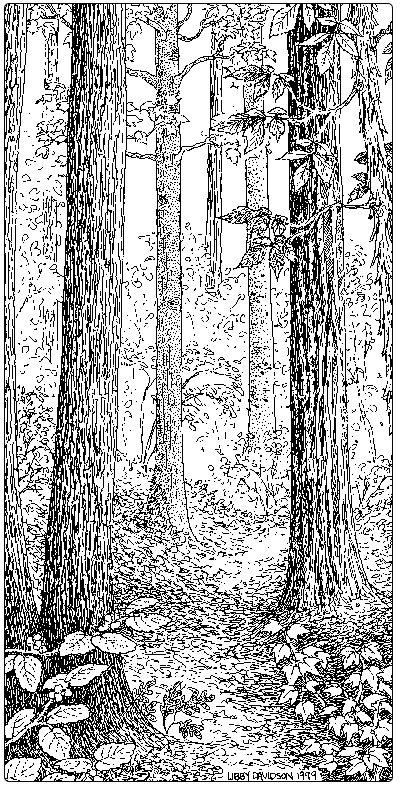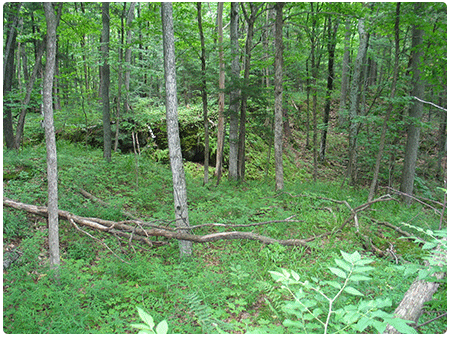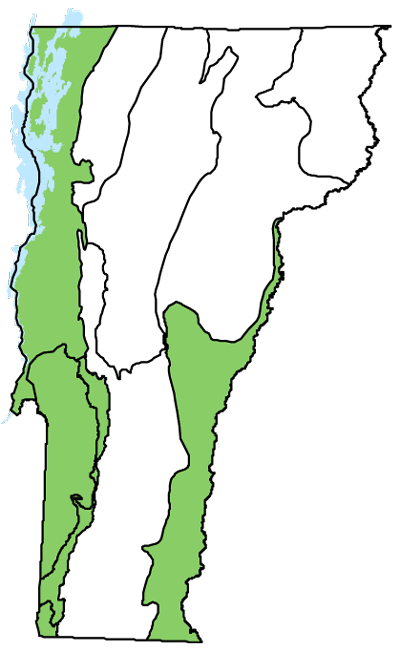Ecology and Physical Setting
The Central Hardwood Forests of the southern Appalachians are known for their tall oaks and hickories, and their stunning displays of spring wildflowers. Hints of this impressive forest reach into the warmer regions of Vermont, where we call it Mesic Maple-Ash-Hickory-Oak Forest. These forests are found on mesic sites and see higher-than-average temperatures and lower-than-average rainfall. They have soils that are typically drier than those in the cooler parts of the state. Parent materials are glacial tills. Bedrock can be close to the surface locally, but shallow bedrock usually creates conditions that favor more drought-tolerant communities.
Mesic Maple-Ash-Hickory-Oak Forests are often found on lower slopes, benches, and coves, where colluvial processes result in the accumulation of soil and nutrients. In many settings, these forests are found on south and west-facing slopes, while cooler north and east-facing slopes harbor northern hardwood communities. The combination of the warm, dry climate and deep, fertile soils results in a distinctive mix of oaks and hickories along with northern hardwoods like sugar maple, white ash and basswood.
Vegetation
Mesic Maple-Ash-Hickory-Oak Forests are diverse. The canopy tends to be a mix of northern hardwoods such as sugar maple, white ash, and basswood, with central hardwoods such as shagbark hickory, bitternut hickory, pignut hickory, white oak, and red oak. Enriched growing conditions in coves and on lower slopes can produce impressively large trees even in relatively young examples of this community. White pine and hemlock are occasionally found in this community but are never abundant. The shrub layer in these forests is sparse to well-developed, depending on the light available. Herb cover also varies, and usually includes species—such as blue-stemmed goldenrod, white snakeroot, and sharp-lobed hepatica—that are indicative of moderate enrichment. Spring wildflower displays can rival those of Rich Northern Hardwood Forests and Dry Oak-Maple Limestone Forests.
The variation in this community is analogous to the variation in Northern Hardwood Forests. Moister sites in coves and hollows will have higher productivity and greater abundances of sugar maple, white ash, white oak, shagbark hickory, bitternut hickory, and basswood, along with a diverse suite of rich-site herbs. Drier and less nutrient-rich settings will have a greater abundance of species such as red maple, beech, black birch, and red oak, and may have depauperate shrub and herb layers.
These forests can provide habitat for species that are common to our south but reach their northern range limits in southern Vermont. Examples include flowering dogwood and round-leaved tick-trefoil. Tulip tree, the classic species of the central hardwoods, grows in this community in extreme southwestern Vermont.
Wildlife Habitat
Wildlife habitat is directly related to the structural complexity of the forest. Mesic Maple-Ash-Hickory-Oak Forests that have structural complexity—in other words, those that have trees of all ages and sizes, numerous large snags, and large fallen trees and their root tip-ups—have conditions that support many wildlife species. In contrast, even-aged forests where all the trees are the same size, with little disturbance that results in dead and downed trees, typically support fewer wildlife species. The mast-producing trees in this community are an important food source for many birds and mammals. Turkeys and gray squirrels are two readily-observed species that rely heavily on mast, but others include deer mouse, white-footed mouse, woodland jumping mouse, and chipmunk. Shagbark hickory is an important tree for Indiana bat and northern long-eared bat. Both bats will roost behind the large flakes of bark.
 Mesic Maple-Ash-Hickory-Oak Forests are abundant on the lower slopes in Vermont’s warmer regions. This, combined with the high diversity of tree and shrub species, make it an important habitat for several species of breeding birds, including wood thrush, eastern wood pewee, yellow-throated vireo, ovenbird, scarlet tanager, cerulean warbler, and northern saw-whet owl. This is one of the warm-climate forests into which red-bellied woodpeckers have expanded their range in recent years.
Mesic Maple-Ash-Hickory-Oak Forests are abundant on the lower slopes in Vermont’s warmer regions. This, combined with the high diversity of tree and shrub species, make it an important habitat for several species of breeding birds, including wood thrush, eastern wood pewee, yellow-throated vireo, ovenbird, scarlet tanager, cerulean warbler, and northern saw-whet owl. This is one of the warm-climate forests into which red-bellied woodpeckers have expanded their range in recent years.
Two uncommon butterflies, hickory hairstreak and West Virginia white, are found in Mesic Maple-Ash-Hickory-Oak Forest, where they are dependent on hickories and toothwort, respectively.
Successional Trends
White pine, paper birch, black birch, and bigtooth aspen are among the early-successional trees that can dominate these forests following disturbance. Because of their landscape position and relatively moist soils, these forests are not prone to fire. Regeneration of tree species likely occurs best in mature forests where windthrow creates tip-ups and exposed mineral soil in canopy gaps.
Related Communities
- Dry Oak-Maple Limestone Forest: Shallow calcareous bedrock results in drier and more nutrient-rich conditions than the typical Mesic Maple-Ash-Hickory-Oak Forest. The bedrock is reflected in understory herbs such as bulblet fern, maidenhair fern, wild ginger, large-flowered trillium, and Dutchman’s breeches.
- Dry Oak-Hickory-Hophornbeam Forest can share many species with Mesic Maple-Ash-Hickory-Oak Forest, but it is found on dry, shallow-to-bedrock ridges and convex slopes with droughty growing conditions. Trees are typically shorter, and the herb layer is characterized by a dense lawn of woodland sedge.
- Dry Hemlock-Oak Forest is characterized by an abundance of eastern hemlock and is generally found on shallow, acidic bedrock.
- Red Oak-Northern Hardwood Forest is generally northern in character. It lacks the white oak and hickory species found in Mesic Maple-Ash-Hickory-Oak Forest.
Conservation Status and Management Considerations
Mesic Maple-Ash-Hickory-Oak Forest is an uncommon natural community type in Vermont. A number of small examples are on conserved lands, but few are mature. Larger examples should be conserved and allowed to become old forests with complex structure. Invasive species pose a substantial threat to many of these forests, especially those recovering from past land clearing, and may be challenging to control. Timber management in these forests should avoid altering the downslope movement of soil and nutrients, maintain a mix of oak, hickory and northern hardwood species in the canopy, and prevent the spread of non-native, invasive species.
Distribution/Abundance
This is an uncommon community in Vermont, restricted to mesic sites in the Champlain Valley, Taconic Mountains, Vermont Valley, and Southern Vermont Piedmont. It has affinities with forest communities that are more common to our south.
Characteristic Plants
Trees
Abundant Species
White oak – Quercus alba
Bitternut hickory – Carya cordiformis
Sugar maple – Acer saccharum
White ash – Fraxinus americana
Occasional to Locally Abundant Species
Shagbark hickory – Carya ovata
Red oak – Quercus rubra
Basswood – Tilia americana
Red maple – Acer rubrum
Eastern hemlock – Tsuga canadensis
White pine – Pinus strobus
Paper birch – Betula papyrifera
Hophornbeam – Ostrya virginiana
Butternut – Juglans cinerea
Black cherry – Prunus serotina
Shrubs

Maple-Ash-Hickory-Oak Forest
Maple-leaved viburnum – Viburnum acerifolium
Shadbushes – Amelanchier spp.
Striped maple – Acer pensylvanicum
Witch hazel – Hamamelis virginiana
Beaked hazelnut – Corylus cornuta
Herbs
Marginal wood fern – Dryopteris marginalis
White snakeroot – Ageratina altissima
Blue-stemmed goldenrod – Solidago caesia
Zigzag goldenrod – Solidago flexicaulis
Sharp-lobed hepatica – Anemone acutiloba
White baneberry – Actaea pachypoda
Christmas fern – Polystichum acrostichoides
Four-leaved milkweed – Asclepias quadrifolia
Common toothwort – Cardamine diphylla
Lance-leaved wild licorice – Galium lanceolatum
Wild licorice – Galium circaezans
Bearded shorthusk – Brachyelytrum aristosum
Minnesota sedge – Carex albursina
Pedunculate sedge – Carex pedunculata
White avens – Geum canadense
Maidenhair fern – Adiantum pedatum
Black-seeded mountain rice – Patis racemosa
Naked tick-trefoil – Hylodesmum nudiflorum
Showy tick-trefoil – Desmodium canadense
Wild ginger – Asarum canadense
Non-native Invasive Plants
Morrow’s honeysuckle – Lonicera morrowii
Tatarian honeysuckle – Lonicera tatarica
Japanese barberry – Berberis thunbergii
Common buckthorn – Rhamnus cathartica
Glossy buckthorn – Frangula alnus
Rare and Uncommon Plants
Pignut hickory – Carya glabra
Flowering dogwood – Cornus florida
Round-leaved tick-trefoil – Desmodium rotundifolium
Squawroot – Conopholis americana
Handsome sedge – Carex formosa
Broad beech fern – Phegopteris hexagonoptera
Hitchcock’s sedge – Carex hitchcockiana
Spicebush – Lindera benzoin
Perfoliate bellwort – Uvularia perfoliata
Short-styled snakeroot – Sanicula canadensis
Puttyroot – Aplectrum hyemale
Early blue violet – Viola palmata
Kalm’s brome grass – Bromus kalmii
Sweet Joe-pye weed – Eutrochium purpureum var. purpureum
American ginseng – Panax quinquefolius
Associated Animals
Eastern red-backed salamander – Plethodon cinereus
Eastern newt – Notophthalmus viridescens
Gray treefrog – Hyla versicolor
DeKay’s brownsnake – Storeria dekayi
Southern flying squirrel – Glaucomys volans
Gray fox – Urocyon cinereoargenteus
Eastern chipmunk – Tamias striatus
Eastern gray squirrel – Sciurus carolinensis
Eastern wood pewee – Contopus virens
Black-billed cuckoo – Coccyzus erythropthalmus
Wood thrush – Hylocichla mustelina
Yellow-throated vireo – Vireo flavifrons
Wild turkey – Meleagris gallopavo
Red-eyed vireo – Vireo olivaceus
Ovenbird – Seiurus aurocapilla
Scarlet tanager – Piranga olivacea
Hairy woodpecker – Picoides villosus
Rose-breasted grosbeak – Pheucticus ludovicianus
Tufted titmouse – Baeolophus bicolor
Rare and Uncommon Animals
Jefferson salamander – Ambystoma jeffersonianum
Blue-spotted salamander – Ambystoma laterale
Indiana bat – Myotis sodalis
Northern long-eared bat – Myotis septentrionalis
Red-bellied woodpecker – Melanerpes carolinus
Northern saw-whet owl – Aegolius acadicus
Cerulean warbler – Setophaga cerulea
West Virginia white – Pieris virginiensis
Hickory hairstreak – Satyrium caryaevorus
Places to Visit
Snake Mountain Wildlife Management Area, Addison, Vermont Department of Fish and Wildlife
Wilmarth Woods, Addison, The Nature Conservancy (TNC)
Helen W. Buckner Memorial Preserve at Bald Mountain, West Haven, TNC
Arms Grant Urban Reserve, Burlington, Burlington Parks and Recreation Department
